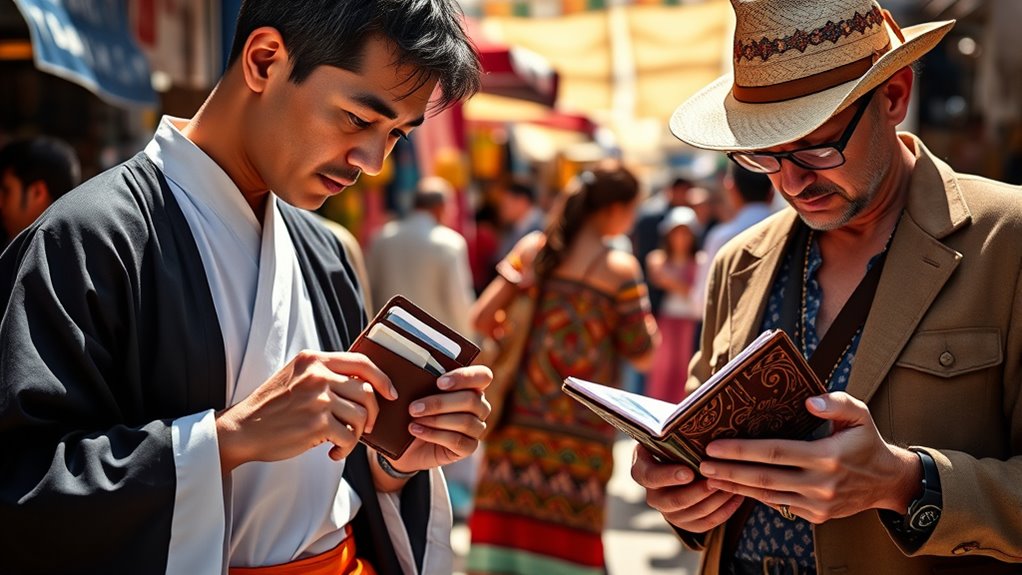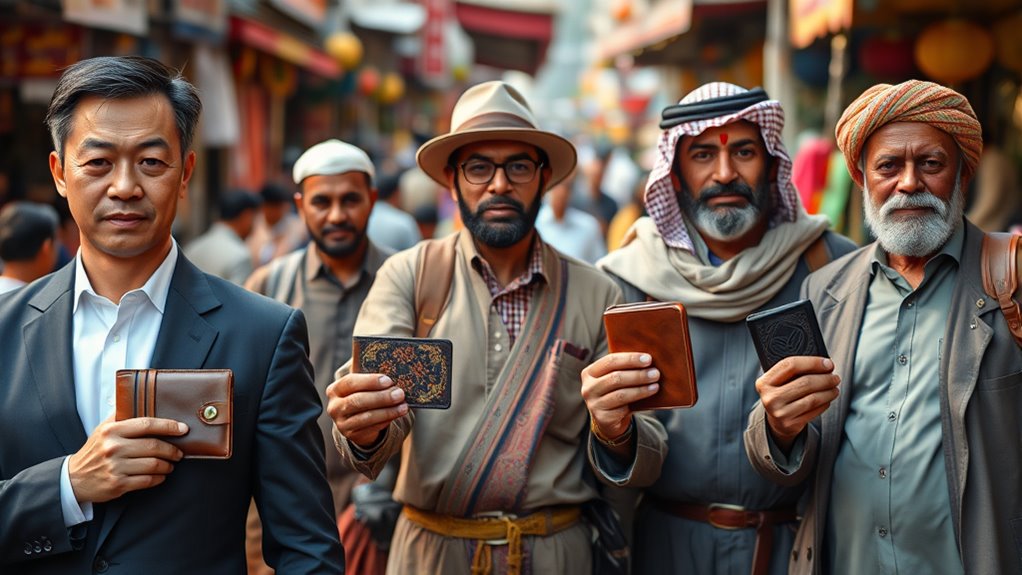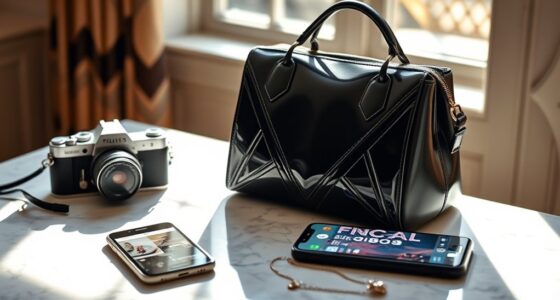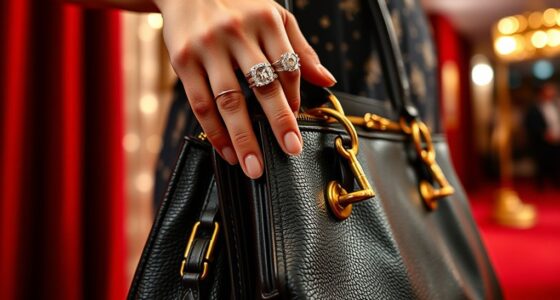Cultural attitudes toward men’s wallets worldwide vary greatly, shaped by social norms, gender roles, and fashion trends. In traditional societies, wallets are practical tools symbolizing responsibility and maturity, often plain and leather. In modern environments, they can be bold fashion statements, displaying confidence and style. Some cultures favor discreet carrying, while others see visible wallets as signs of status. Exploring these differences reveals how wallets reflect societal values—if you explore further, you’ll discover even more fascinating insights.
Key Takeaways
- Cultural values influence whether men prefer minimalist leather wallets or more decorative, fashion-forward designs.
- Traditional societies favor simple, practical wallets as symbols of responsibility and maturity.
- Modern cultures see wallets as fashion statements, expressing confidence, style, and individual identity.
- Display and carrying styles, such as visible or discreet wallets, reflect societal attitudes toward confidence and humility.
- Wallets serve as personal symbols that mirror cultural expectations, social status, and evolving gender norms worldwide.

Men’s wallets are more than just practical accessories; they reflect cultural values and social attitudes that vary across societies. When you carry a wallet, you’re not only managing your cash and cards but also subtly expressing your identity, status, and adherence to societal expectations. In many cultures, gender roles influence how men approach their wallets. For instance, in traditional societies, men are expected to carry minimalist, functional wallets—often plain, leather designs that emphasize practicality over style. These wallets symbolize responsibility and maturity, aligning with the cultural idea that men should be prepared and self-sufficient. Conversely, in more progressive environments, the lines between gender roles are blurred, and wallets become fashion statements. You might see men choosing wallets with bold colors, intricate patterns, or designer logos, signaling confidence and a sense of personal style. These choices reflect a shift in societal attitudes that view masculinity not just as stoicism but as an opportunity for self-expression.
Fashion trends also play a significant role in shaping how men view their wallets and how society perceives them. In recent years, minimalist wallets have surged in popularity, driven by the trend toward sleek, clutter-free accessories. These wallets appeal to men who prioritize efficiency and modern aesthetics, aligning with contemporary fashion trends that favor simplicity. On the other hand, vintage or rugged leather wallets harken back to traditional masculinity, emphasizing durability and craftsmanship. As fashion trends evolve, so does the symbolism of wallets—some men see theirs as a way to showcase sophistication, while others prefer a rugged, utilitarian look that hints at adventure or resilience. Additionally, the material quality of a wallet often influences perceptions of a man’s social status and attention to detail.
Cultural attitudes toward wallets also influence how men carry and display them. In some societies, visible wallets are considered a sign of confidence and style, often showcased in front pockets or even as part of a fashion statement. In contrast, others view discreetly carrying a wallet as a sign of humility or prudence. The design and size of wallets also reveal social attitudes; slim wallets suggest an appreciation for efficiency and modernity, while larger, more ornate wallets might symbolize status and wealth.
Ultimately, your choice of wallet—its style, size, and how you carry it—can be a subtle reflection of the cultural and social values that shape your identity. Whether adhering to traditional gender roles or embracing contemporary fashion trends, your wallet becomes a personal emblem that communicates who you are within your society’s cultural framework.
Frequently Asked Questions
How Do Men’s Wallets Reflect Social Status Globally?
Men’s wallets often reflect social status through luxury branding and traditional craftsmanship. When you choose a high-end designer wallet, you showcase your wealth and taste, signaling your social standing. Handcrafted leather wallets from skilled artisans also highlight exclusivity and quality, making a statement about your sophistication. By selecting these premium options, you demonstrate that you value heritage and craftsmanship, positioning yourself within a higher social echelon.
Are There Specific Wallet Styles Preferred in Different Cultures?
Imagine holding a finely crafted leather wallet, its traditional craftsmanship shining through intricate stitching. Different cultures favor styles that showcase regional symbolism—like ornate patterns in Asia or minimalist designs in Europe. You’ll find that preferences vary, with some regions valuing function over form, while others cherish wallets that tell a cultural story. These styles reflect deep-rooted traditions, making each wallet a small piece of regional identity.
How Do Gender Norms Influence Wallet Design Preferences?
Gender norms shape your wallet preferences by emphasizing masculinity symbols and traditional expectations. You might favor sturdy, minimalist designs that reflect strength and practicality, aligning with societal views of masculinity. Conversely, if you challenge gender expectations, you could opt for more diverse styles or colors. Overall, these norms influence what you see as appropriate or desirable, guiding your choices to either conform to or rebel against established masculinity symbols in wallet design.
What Are Emerging Trends in Men’s Wallet Fashion Worldwide?
You’ll notice that emerging trends in men’s wallet fashion emphasize luxury branding and minimalist design. Men now prefer sleek, understated styles that showcase quality without excess. High-end brands are incorporating subtle logos and premium materials, appealing to modern tastes. This shift reflects a desire for functional yet stylish accessories. As these trends grow, expect more innovative, minimalist wallets that blend sophistication with practicality, catering to diverse cultural preferences worldwide.
How Do Regional Economic Factors Affect Wallet Materials and Prices?
You’ll notice regional economic factors like currency fluctuations and import tariffs impact wallet prices and materials. When your local currency weakens, imported wallets become pricier, and manufacturers may switch to cheaper materials. Conversely, low tariffs and stable currency rates can lower costs, allowing for higher-quality materials. These economic shifts influence what wallets are available and how much you pay, making it essential to stay aware of regional financial changes.
Conclusion
Just like a wallet reflects your cultural values, it’s a small mirror of your society’s attitude toward masculinity. Imagine holding a wallet that’s worn and battered—like a badge of resilience in some cultures, or a symbol of practicality elsewhere. Remember, what you carry in your wallet isn’t just cash or cards, but a story of identity and tradition. Embrace these cultural nuances, and you’ll see how a simple wallet can hold more than just money—it holds history.









